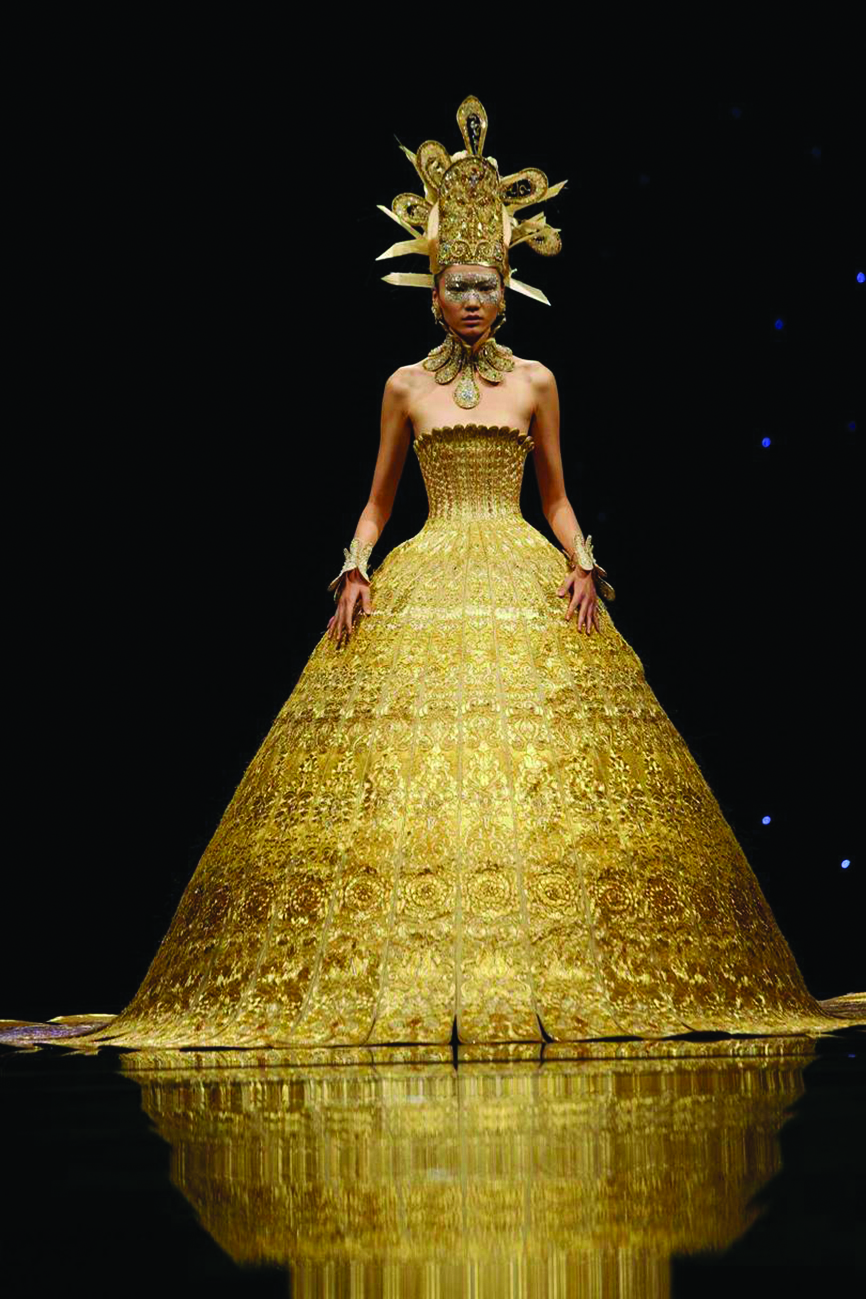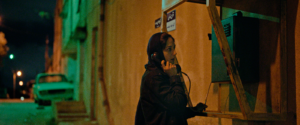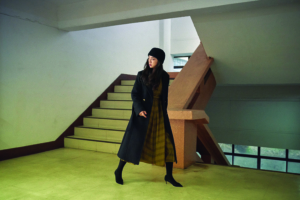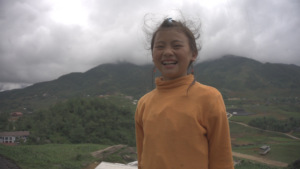Having made an impact following its world premiere at the Tribeca Film Festival in 2018, Pietra Brettkelly’s Yellow Is Forbidden cements the New Zealand filmmaker’s reputation for taking audiences on fascinating cross-cultural journeys. This documentary is the result of nearly two years spent with Chinese fashion designer Guo Pei across six countries, chronicling the couturier’s quest to gain the ultimate respect in the fashion world: an invitation to Paris’ Chambre Syndicale de la Haute Couture. As well as being an exquisite visual spectacle that showcases the intricacy and beauty of Guo’s creations, the film explores the interactions between Eastern and Western cultures in the world of high fashion. Brettkelly pays respect to her subject’s Chinese heritage through explorations of the sociohistorical and cultural references in Guo’s work, while allowing us to witness the designer’s sometimes-tenuous relationship with the largely Eurocentric fashion world.
The term ‘haute couture’ is protected under French law, and use of it requires approval by the Chambre Syndicale de la Haute Couture.[1]See ‘La Haute Couture’, Fédération de la Haute Couture et de la Mode website, <https://fhcm.paris/en/the-federation/history/>, accessed 22 February 2019. Its historical and cultural significance remains strong, even in a world of ubiquitous brands and fast fashion, as it is synonymous with handmade, exquisitely designed and, of course, wildly expensive goods. Guo’s love of the couture tradition and her almost encyclopedic knowledge of designers (Cristóbal Balenciaga is a favourite) is explored early in the film, and the lofty esteem with which she holds French fashion sets the scene for her journey. She likens haute couture recognition for a designer to an Oscar win for a film director – and, similar to films, each of her collections requires an intensive time commitment and involves an army of workers in the background.
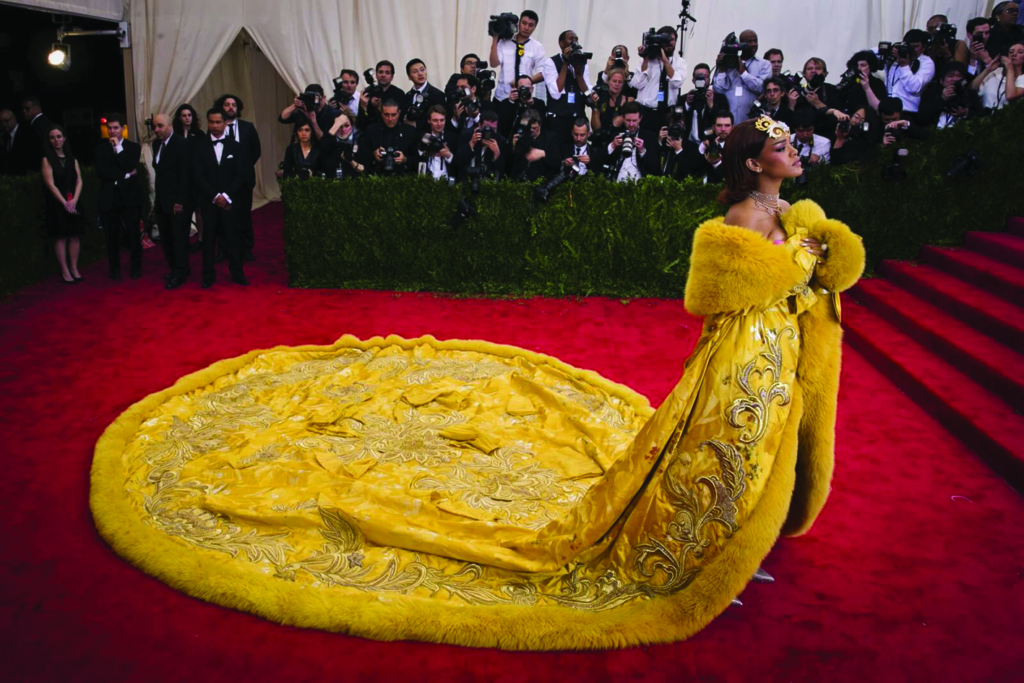
The insight that Yellow Is Forbidden offers into the creation of each garment is mind-boggling: from design concept to catwalk, a single garment – such as the yellow cape famously worn by singer Rihanna to the 2015 Met Gala – can take up to two years to complete. In the film, we observe Guo visiting an embroidery workshop in China to check the progress of the workers; as the country is synonymous with mass production (and designer knock-offs), it is refreshing to be shown the attention to detail and level of expertise required to embroider one of Guo’s gowns. At the same time, as critic Keith Uhlich has pointed out, Brettkelly does not shy away from showing the ‘routine tedium’ experienced by those who put in those hours, especially in contrast to the more glamorous life of the couturier herself.[2]Keith Uhlich, ‘Yellow Is Forbidden: Film Review | Tribeca 2018’, The Hollywood Reporter, 23 April 2018, <https://www.hollywoodreporter.com/review/yellow-is-forbidden-review-1104820>, accessed 22 February 2019.
Guo’s family life is shown as an important driver for both grounding her in her culture and achieving professional success … the high standard Guo demands of her artisans can be traced back to this desire to honour her family and her country’s history.
Yet Brettkelly does also expose us to the person behind the jetsetter, emphasising the twenty-plus years of hard work that enabled her to achieve the ‘overnight’ (Western) recognition brought by Rihanna’s wearing of her design. In a pre–Yellow Is Forbidden article, The New Yorker’s Judith Thurman identifies two Guo Peis. The first one designs demi-couture items for her customer base in China, which are quite conservative in style: ‘a uniform for women performing an old-fashioned role’.[3]Judith Thurman, ‘The Empire’s New Clothes’, The New Yorker, 21 March 2016, <https://www.newyorker.com/magazine/2016/03/21/guo-pei-chinas-homegrown-high-fashion-designer>, accessed 22 February 2019. She also makes traditional Chinese wedding dresses and evening gowns that embrace and promote Chinese culture, featuring phoenix and dragon imagery in their embroidery. The film shows Guo with this client base – she refers to them as ‘ordinary women’, an unusual choice of words for an elite group with so much wealth that they can afford her designs – and we learn that they are indeed the bread and butter of her business: their purchases support her more expensive and time-consuming masterpieces. Her respect for and careful attention to these clients are obvious, but her interactions with them also reveal her complicated attitudes towards the Western fashion world. She candidly comments, ‘Even though China is rich in culture, [Western fashion-industry members are] prejudiced against us because we’re from the East.’ Yet she and her clients also discuss Asian women having plastic surgery to make their features appear more ‘European’, and she warns the women not to wear traditional cheongsams, presumably for fear of looking too provincial. As Brettkelly has said of her subject, ‘Guo Pei doesn’t have all the inspirations of the West, but she strives for acceptance there. She treads the line between assimilation and acceptance.’[4]Pietra Brettkelly, quoted in Alice Newbold, ‘Yellow Is Forbidden Is a Celebration of How Remarkable Women Are’, Vogue, 4 May 2018, <https://www.vogue.co.uk/article/guo-pei-yellow-is-forbidden-pietra-brettkelly>, accessed 22 February 2019.
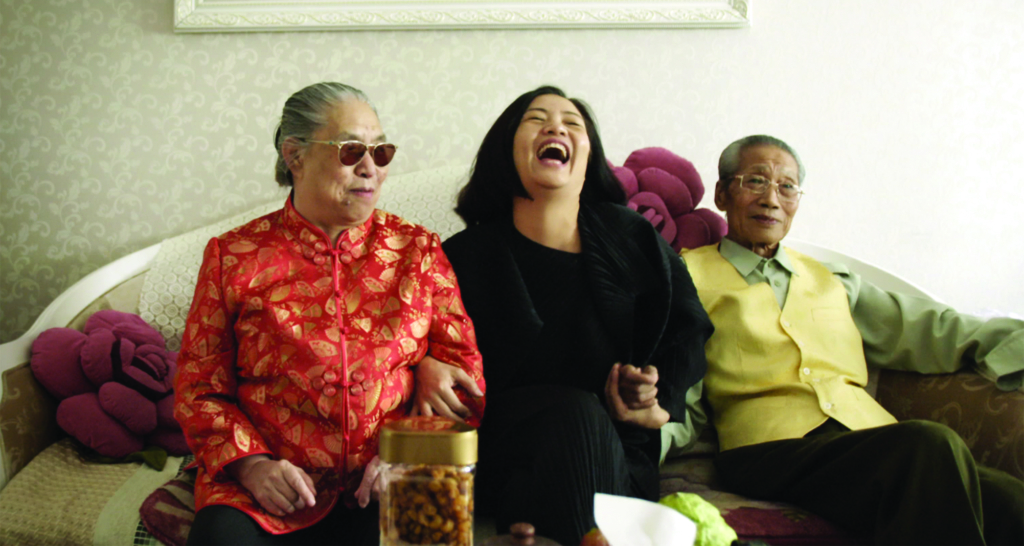
Guo’s family life is shown as an important driver for both grounding her in her culture and achieving professional success; with her sights set on the West, maintaining this connection to her past is important. We are given access to her private life; scenes filmed in her home show her at work in her study, producing drawings of exquisite garments and revealing her quirky personality traits, such as her collection of hundreds of teddy bears. Her husband, Cao Bao Jie, is her main investor, and often acts as her translator. She refers to him as her ‘wings’ and, as we see throughout the documentary, he is never far from her side. In one of Yellow Is Forbidden’s most touching scenes, Guo visits her ageing parents and recounts to them the difficulties of growing up and becoming a designer in an era of extraordinary change in China. She reflects on her grandmother’s influence on her choice to pursue the profession and create beautiful works of art. We also learn that it was her grandmother who taught her to embroider, and that the high standard Guo demands of her artisans can be traced back to this desire to honour her family and her country’s history. Later, the film introduces us to Guo’s daughter; the designer mentions her hopes that her daughter will carry the mantle and become a designer herself someday.
Feeling the weight of emerging as one of few Asian designers to be accepted into the haute couture world, Guo states, ‘I am not a nation,’ asserting her wish to be accepted as a designer first and foremost, rather than as a representative of her culture and country.
The second Guo that Thurman identifies is the expert couturier that Yellow Is Forbidden spends most of its time with. Thurman calls her a ‘fabulist of sovereign fancy’, whose creations contain both ‘fantastical decoration that alludes to her own heritage’ and various other historical and artistic references.[5]Thurman, op. cit. The collection of Guo’s that is presented in the film, spring/summer 2017’s Legend, takes its cues from a Christian cathedral, a deliberate step away from presenting influences from her Chinese background. Feeling the weight of emerging as one of few Asian designers to be accepted into the haute couture world, Guo states, ‘I am not a nation,’ asserting her wish to be accepted as a designer first and foremost, rather than as a representative of her culture and country. This is one of the film’s most interesting conceptual junctures, pitting East against West, and encourages the audience to ask: do we expect too much from artists in terms of representing their cultural heritage/s? After all, if we are all global citizens in a global economy, surely, artists are free to explore a range of influences?
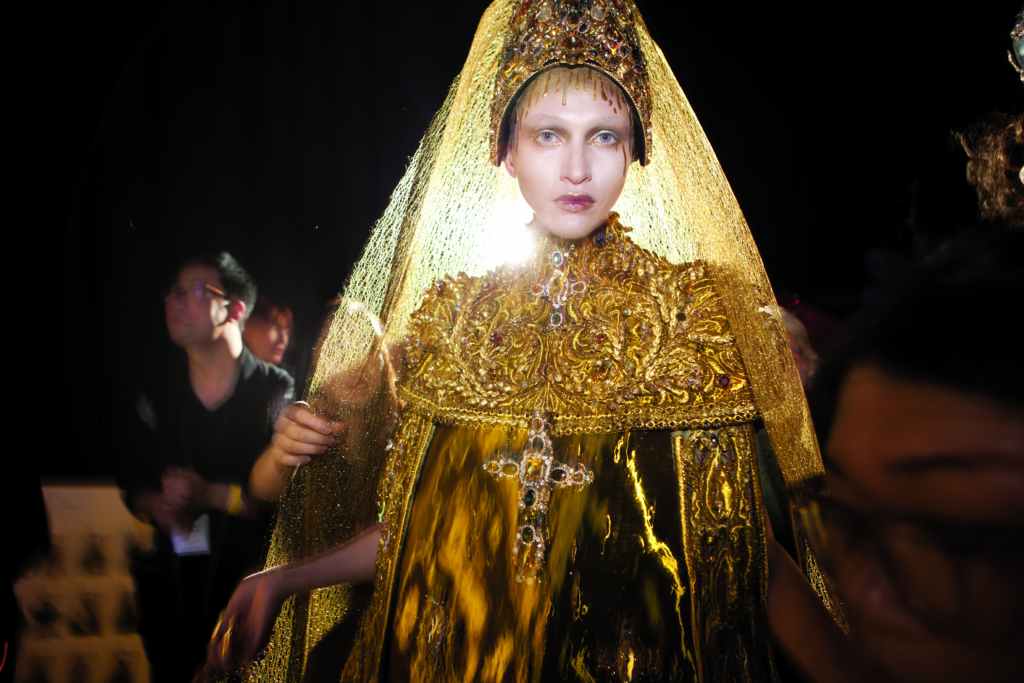
Even beyond Guo’s work, cultural appropriation remains a hot-button topic in a number of artistic fields, including fashion itself. Creative consultant and stylist Megha Kapoor asserts, ‘Borrowing from other cultures is inherently a part of the creative process,’ describing fashion as a space for the celebration of different cultures.[6]Megha Kapoor, quoted in Anisha Khopkar, ‘We Need to Talk About Cultural Appropriation in Fashion’, ABC Life, 28 November 2018, <https://www.abc.net.au/life/cultural-appropriation-and-fashion/10501010>, accessed 22 February 2019. But, as writer Anisha Khopkar points out, this ‘becomes problematic when historical context and cultural sensitivities are ignored’, citing as examples Gucci’s incorporation of turbans, Chanel’s sale of a boomerang as an ‘accessory’ and Victoria’s Secret’s use of a Native American headdress.[7]Khopkar, ibid. Fashion photographer Luca Camaiani, in his review of an exhibition of Guo’s work in Canada, recognises that the current political climate may cause some to jump to conclusions regarding cultural appropriation, but feels very strongly that Guo’s output balances ‘[W]estern cultural influence with a clear Asian identity, and by doing so, possibly challenges popular connotations of cultural appropriation’. He invites us to instead question the charges that paint Guo’s work as appropriative, contending that it is both respectful of its cultural influences and artistically beautiful.[8]Luca Camaiani, ‘Guo Pei, Appropriating Beautifully’, Medium, 14 November 2018, <https://medium.com/@lucacamaiani/guo-pei-appropriating-beautifully-e6fdb8ef427d>, accessed 22 February 2019. Elsewhere, fashion journalist Osman Ahmed argues, ‘Well-intentioned appropriation can be a force for good, creating a cultural exchange and enriching the available vocabulary for designers, artists and image-makers.’ Mentioning fusions in cuisine as accepted forms of cultural melding, he asks why fashion can’t be free to do the same without fear of criticism, and encourages all designers to look to Guo’s work as an example of how culture can be meaningfully explored in their industry.[9]Osman Ahmed, ‘Why Fashion Needs Cultural Appropriation’, The Business of Fashion,1 June 2017, <https://www.businessoffashion.com/articles/opinion/why-fashion-needs-cultural-appropriation>, accessed 22 February 2019. Yellow Is Forbidden builds on the conversation around this complex issue, particularly as we are more likely to have discussed Western designers aping Eastern cultural influences in the past, rather than the reverse.
The film culminates in the Legend catwalk show, with its accompanying on- and offstage drama. It is here, perhaps, that we get to see all the facets of Guo: the mother strongly bonded to her family, her daughter by her side; the accomplished designer at the helm of an impressive production; the nervous Eastern visitor on the precipice of having her dream of being accepted in the West realised. We see few Asian faces on Guo’s catwalk, but, again, is there an obligation to be representative? The spectacular final gown is worn by the then-85-year-old New York model Carmen Dell’Orefice. Again, Guo has defied expectations, choosing to employ an octogenarian Western woman in an industry and from a culture obsessed with youth – arguably a comment on the timeless nature of beauty that she projects in her work.
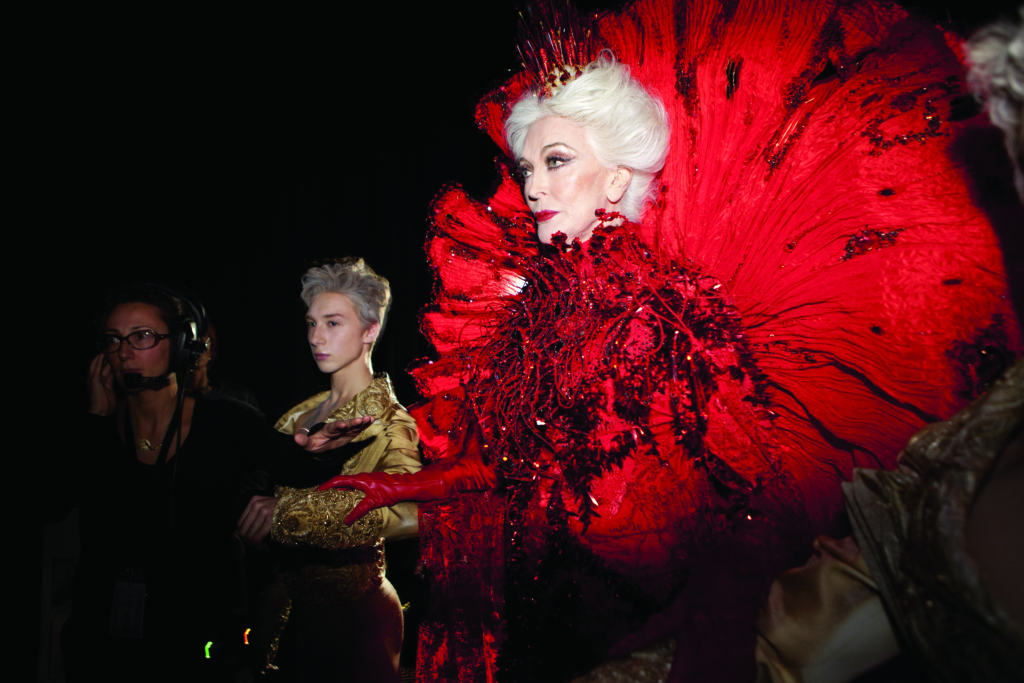
Octogenarian model Carmen Dell’Orefice at Guo’s Legend show
Interestingly, critics have disagreed on the scope of this documentary’s appeal: while The New Zealand Herald’s Francesca Rudkin suggests that ‘you don’t need to be interested in fashion to enjoy this visual feast of a film’,[10]Francesca Rudkin, ‘Movie Review: Yellow Is Forbidden’, The New Zealand Herald, 1 November 2018, <https://www.nzherald.co.nz/entertainment/news/article.cfm?c_id=1501119&objectid=12151242>, accessed 22 February 2019. Screen Daily’s Wendy Ide believes that it ‘will struggle to claim much of an audience outside of individuals with a vested interest in fashion’.[11]Wendy Ide, ‘Yellow Is Forbidden: Tribeca Review’, Screen Daily, 22 April 2018, <https://www.screendaily.com/reviews/yellow-is-forbidden-tribeca-review/5128274.article>, accessed 22 February 2019. Yes, an interest in the fashion world is perhaps the major drawcard of Yellow Is Forbidden, with its insights into the nature of that bastion of extravagant consumerism that is haute couture. But our aspirational fascination with luxury brands extends well beyond this limited target market: while few of us can ever hope to own a Chanel suit, we might spring for a bottle of N° 5 perfume as a treat. Guo herself has also released a range of cosmetics in collaboration with MAC.[12]See Felicity Kinsella, ‘MAC Team Up with Chinese Couture Designer Guo Pei on Capsule Collection’, i-D, 1 May 2015, <https://i-d.vice.com/en_au/article/ywd3yj/mac-team-up-with-chinese-couture-designer-guo-pei-on-capsule-collection>, accessed 22 February 2019. Haute couture’s survival, despite its exclusivity, rests on a broader connection to consumers: its effect on the wider consciousness spans everything from a pop star wearing a desired gown to the availability of more ‘affordable’ creations.
Yellow Is Forbidden was but one significant film about a fashion designer that made the festival rounds last year; two other notable titles were McQueen (Ian Bonhôte, 2018) and Westwood: Punk, Icon, Activist (Lorna Tucker, 2018).Although Guo may lack the recognition and notoriety of the subjects of these two films, critic Richard Gray believes Brettkelly’s film is on par with them in its ability to capture the artist’s process.[13]Richard Gray, ‘Westwood, Guo, and McQueen: Cuts of Fashion on Screen’, The Reel Bits, 18 June 2018, <https://thereelbits.com/2018/06/18/westwood-guo-and-mcqueen-cuts-of-fashion-on-screen/>, accessed 22 February 2019. Thanks to Jacob Bryant’s cinematography, Yellow Is Forbidden is also a visually stunning work that stretches far beyond pretty pictures of pretty clothes. In particular, the use of shadow puppets during narrative exposition and close-ups of both gowns and imagery such as swimming fish adds visual interest while referencing the designer’s Eastern roots. Beyond the aforementioned peek it offers into a specific world (in this case, that of haute couture), the appeal of any fly-on-the-wall documentary sits with its subject; Brettkelly’s portrayal of Guo, with all her contradictions, leaves the audience, whether interested in fashion or not, wanting to know more about her.
https://www.madmanfilms.com.au/yellow-is-forbidden/
Endnotes
| 1 | See ‘La Haute Couture’, Fédération de la Haute Couture et de la Mode website, <https://fhcm.paris/en/the-federation/history/>, accessed 22 February 2019. |
|---|---|
| 2 | Keith Uhlich, ‘Yellow Is Forbidden: Film Review | Tribeca 2018’, The Hollywood Reporter, 23 April 2018, <https://www.hollywoodreporter.com/review/yellow-is-forbidden-review-1104820>, accessed 22 February 2019. |
| 3 | Judith Thurman, ‘The Empire’s New Clothes’, The New Yorker, 21 March 2016, <https://www.newyorker.com/magazine/2016/03/21/guo-pei-chinas-homegrown-high-fashion-designer>, accessed 22 February 2019. |
| 4 | Pietra Brettkelly, quoted in Alice Newbold, ‘Yellow Is Forbidden Is a Celebration of How Remarkable Women Are’, Vogue, 4 May 2018, <https://www.vogue.co.uk/article/guo-pei-yellow-is-forbidden-pietra-brettkelly>, accessed 22 February 2019. |
| 5 | Thurman, op. cit. |
| 6 | Megha Kapoor, quoted in Anisha Khopkar, ‘We Need to Talk About Cultural Appropriation in Fashion’, ABC Life, 28 November 2018, <https://www.abc.net.au/life/cultural-appropriation-and-fashion/10501010>, accessed 22 February 2019. |
| 7 | Khopkar, ibid. |
| 8 | Luca Camaiani, ‘Guo Pei, Appropriating Beautifully’, Medium, 14 November 2018, <https://medium.com/@lucacamaiani/guo-pei-appropriating-beautifully-e6fdb8ef427d>, accessed 22 February 2019. |
| 9 | Osman Ahmed, ‘Why Fashion Needs Cultural Appropriation’, The Business of Fashion,1 June 2017, <https://www.businessoffashion.com/articles/opinion/why-fashion-needs-cultural-appropriation>, accessed 22 February 2019. |
| 10 | Francesca Rudkin, ‘Movie Review: Yellow Is Forbidden’, The New Zealand Herald, 1 November 2018, <https://www.nzherald.co.nz/entertainment/news/article.cfm?c_id=1501119&objectid=12151242>, accessed 22 February 2019. |
| 11 | Wendy Ide, ‘Yellow Is Forbidden: Tribeca Review’, Screen Daily, 22 April 2018, <https://www.screendaily.com/reviews/yellow-is-forbidden-tribeca-review/5128274.article>, accessed 22 February 2019. |
| 12 | See Felicity Kinsella, ‘MAC Team Up with Chinese Couture Designer Guo Pei on Capsule Collection’, i-D, 1 May 2015, <https://i-d.vice.com/en_au/article/ywd3yj/mac-team-up-with-chinese-couture-designer-guo-pei-on-capsule-collection>, accessed 22 February 2019. |
| 13 | Richard Gray, ‘Westwood, Guo, and McQueen: Cuts of Fashion on Screen’, The Reel Bits, 18 June 2018, <https://thereelbits.com/2018/06/18/westwood-guo-and-mcqueen-cuts-of-fashion-on-screen/>, accessed 22 February 2019. |
